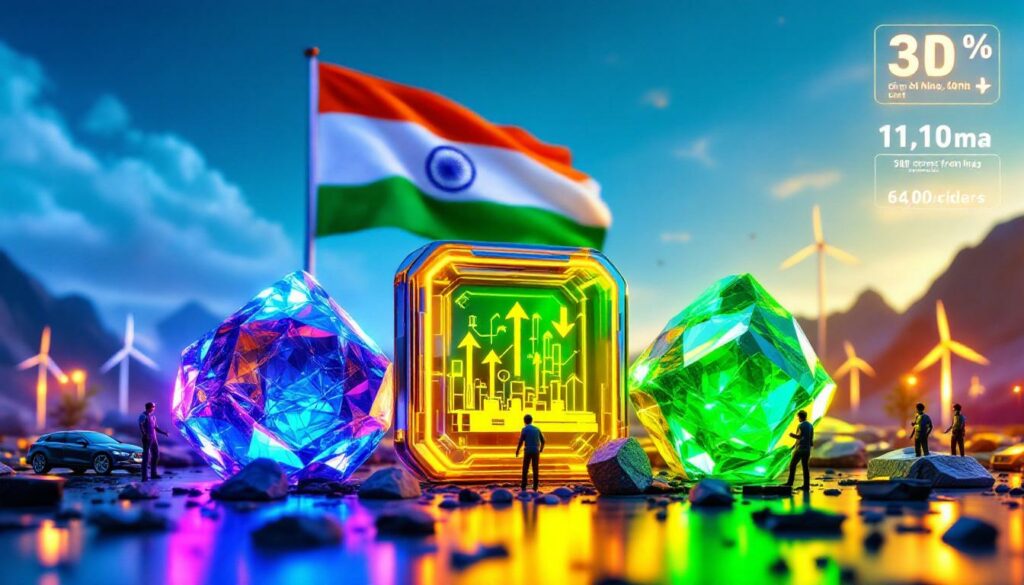India Plans to Kickstart Rare Earth Output to Cut China Reliance
Rare earth elements (REEs) are a group of 17 metallic elements with unique magnetic, luminescent, and electrochemical properties that make them essential components in numerous high-tech applications. Despite their name, these elements are actually relatively abundant in the Earth's crust, but economically viable deposits are less common. What makes REEs truly valuable isn't their scarcity but their exceptional properties that cannot be easily substituted with alternative materials.
The importance of REEs has grown exponentially with the advancement of technology. They serve as critical components in electric vehicle motors, wind turbines, smartphones, advanced weaponry, medical equipment, and countless other modern technologies. For example, neodymium and praseodymium are vital for creating the strongest permanent magnets available, which power the motors in electric vehicles and generators in wind turbines.
The Critical Role of Rare Earth Elements in Modern Technology
The transition to green energy and advanced computing has made REEs more important than ever. A single F-35 fighter jet requires approximately 920 pounds of rare earth materials, while a typical electric vehicle uses about 2-4 kg of rare earth magnets. Wind turbines can contain several hundred kilograms of these elements, particularly in direct-drive models that eliminate the need for gearboxes.
What makes REEs irreplaceable is their unique electron configuration, which gives them exceptional magnetic strength relative to their weight. This property allows manufacturers to create smaller, lighter, and more efficient components than would be possible with conventional materials. For example, neodymium magnets are up to 10 times stronger than traditional ferrite magnets of the same size.
Global Supply Chain Vulnerabilities
The concentration of rare earth processing has created significant vulnerabilities in global supply chains. China controls approximately 90% of global rare earth processing capacity, creating a critical dependency for manufacturing nations worldwide. This dominance stems from decades of strategic investments, less stringent environmental regulations, and technical expertise development.
Recent Chinese export restrictions have sent shockwaves through global mining landscape. In 2024, China implemented stricter controls on gallium, germanium, and certain rare earth materials, citing national security concerns. These restrictions have disrupted supply chains for automobile manufacturers worldwide, including those operating in India.
"The rare earth supply chain represents one of the most significant concentration risks in the global economy," notes industry analyst Dr. Samantha Chen of the Critical Materials Institute. "When a single country controls 90% of processing for materials essential to green technology, defense systems, and communications infrastructure, it creates systemic vulnerabilities."
How Is India Planning to Boost Rare Earth Production?
India's government has recognized the strategic importance of developing domestic rare earth capabilities. With growing tensions in global trade and increasing demand for clean energy technologies, securing reliable access to these critical minerals energy security has become a national priority. India's approach focuses on creating economic incentives to stimulate private sector involvement while ensuring the development of a complete domestic supply chain.
The $290 Million Incentive Program
The centerpiece of India's critical minerals strategy is a comprehensive incentive program worth approximately 25 billion rupees ($290 million). This initiative aims to attract private manufacturers to invest in rare earth magnet production facilities within India. The program targets the production of about 4,000 tons of neodymium and praseodymium-based magnets over a seven-year period.
The plan follows a model similar to India's successful Production-Linked Incentive (PLI) schemes in other sectors, which have helped boost domestic manufacturing of electronics, pharmaceuticals, and solar panels. By providing financial support during the critical early stages, the government hopes to overcome the significant barriers to entry that have previously deterred private investment.
Structure of the Proposed Incentives
The incentive structure has been carefully designed to balance immediate financial support with long-term sustainability:
- A two-year gestation period for setting up manufacturing facilities
- Five years of financial incentives following the commencement of production
- Support for investments of up to 6 billion rupees for every 1,000 tons of production capacity
- Bidding opportunities for annual production capacity between 500-1,500 tons
Companies participating in the program will compete through a bidding process, with incentives weighted toward those proposing larger capacity and higher domestic content. This competitive structure aims to maximize the program's effectiveness while ensuring that participants have realistic plans for long-term viability.
Domestic Sourcing Requirements
A critical aspect of India's sourcing strategy is ensuring the development of a complete domestic supply chain, not just assembly operations dependent on imported materials. To qualify for incentives, manufacturers must meet stringent domestic content requirements:
- Initially, 50% of the value of the final product must come from locally produced neodymium-praseodymium oxide
- This requirement increases to 80% by the fifth year of manufacturing
- Raw materials must be sourced from Indian mines or processing facilities
These requirements aim to prevent the creation of superficial manufacturing operations that remain dependent on foreign inputs. Instead, the policy encourages the development of expertise across the entire value chain, from mining and separation to magnet manufacturing and integration into end products.
Which Companies Are Showing Interest in India's Rare Earth Initiative?
The announcement of India's rare earth incentive program has sparked significant interest from major industrial players who recognize both the strategic importance and commercial potential of this emerging sector. Several prominent Indian conglomerates have already expressed interest in participating in the bidding process.
Major Indian Conglomerates Entering the Sector
-
Vedanta Group: Led by billionaire Anil Agarwal, this mining and resources giant has acknowledged the strategic importance of rare earth magnets. A Vedanta spokesperson stated, "Our interest in rare earth magnet manufacturing stems from its strategic importance to green technologies. These materials are fast becoming new levers of global influence." The company's extensive experience in mining operations provides a natural foundation for expanding into rare earth processing.
-
JSW Group: Headed by Sajjan Jindal, this diversified conglomerate with interests in steel, energy, infrastructure, and cement has shown interest in expanding into critical minerals. JSW's established industrial expertise and financial resources position it well to enter the rare earth sector as part of a broader strategy to participate in India's green energy transition.
-
Sona BLW Precision Forgings Ltd.: As one of India's largest manufacturers of traction motors for electric vehicles, Sona Comstar has announced plans to produce rare earth magnets locally to reduce its dependence on Chinese imports. CEO Vivek Vikram Singh has indicated they may seek technology partnerships to develop the necessary expertise, stating, "Producing magnets will help secure the supply chain for our motor business." The company's existing relationships with automakers provide a ready market for domestically produced magnets.
These companies bring different strengths and motivations to the rare earth sector. Vedanta and JSW possess significant mining and industrial expertise, while Sona BLW represents the downstream manufacturing perspective with direct links to end-use applications in electric vehicles.
Strategic Motivations for Corporate Interest
The interest from major industrial groups reflects several strategic calculations beyond simple profit motives:
-
Supply chain security: Companies like Sona BLW recognize that controlling critical inputs provides protection against market disruptions and price volatility.
-
Market positioning: Early movers in India's rare earth sector could establish dominant positions in a market expected to grow significantly as India's electric vehicle and renewable energy sectors expand.
-
Government relations: Participation in strategically important national initiatives can strengthen relationships with government stakeholders.
-
Long-term competitive advantage: Developing expertise in rare earth processing represents a high-barrier-to-entry capability that could provide lasting competitive advantages as demand for these materials grows.
Industry analysts note that these companies are likely to pursue different strategies, with some focusing on vertical integration while others may specialize in specific parts of the value chain through strategic partnerships.
What Challenges Does India Face in Developing Its Rare Earth Industry?
Despite the strategic importance and government support, India's ambitious rare earth plans face substantial challenges. Developing a competitive rare earth industry requires overcoming economic, technical, and environmental hurdles that have previously limited the sector's growth outside China.
Economic Viability Without Subsidies
The fundamental economic challenge is stark: producing rare earth magnets in India without government support is currently not financially viable. Analysis from the industry reveals that the return on investment for rare earth magnet production projects is negative without both capital and operating subsidies.
Several factors contribute to this challenging economics:
-
High capital costs: Setting up separation facilities and magnet manufacturing plants requires significant upfront investment in specialized equipment.
-
Operational complexity: The processing of rare earth ores involves numerous complex chemical processes with high operating costs.
-
Scale disadvantages: Indian operations will initially operate at smaller scales than established Chinese facilities, creating unit cost disadvantages.
-
Limited domestic expertise: The need to import technical knowledge and possibly equipment adds to project costs.
The necessary oxide is currently supplied by state-owned Indian Rare Earths Ltd., but even with this domestic source, the economics remain challenging. Industry estimates suggest that government support may need to cover 15-20% of production costs in the early years to make projects viable.
Technical Know-How and Infrastructure Gaps
Technical expertise in rare earth processing remains heavily concentrated in China, creating significant knowledge gaps for new entrants. Developing this expertise involves several challenges:
-
Processing complexity: Separating individual rare earth elements requires sophisticated solvent extraction techniques with hundreds of processing steps.
-
Equipment requirements: Specialized processing equipment may need to be imported, as domestic manufacturing capabilities are limited.
-
Workforce development: Training engineers and technicians in rare earth processing techniques requires time and resources.
-
Research infrastructure: India has limited research facilities focused specifically on rare earth processing and magnet manufacturing.
Mines and processing facilities typically require 3-5 years to develop from planning to full operation, making the seven-year timeframe for the program ambitious. Technical partnerships with countries like Japan, Australia, or the United States could help address some of these gaps but would require careful intellectual property arrangements.
Environmental and Regulatory Considerations
Rare earth mining and processing present significant environmental challenges that must be addressed for sustainable development:
-
Low concentration in ore: Rare earth elements typically constitute only 0.05-0.5% of mined ore, requiring extensive processing that generates large volumes of waste material.
-
Radioactive associations: Many rare earth deposits contain thorium and uranium, requiring specialized handling and disposal protocols.
-
Chemical processing: Separation processes use large quantities of acids, bases, and organic solvents that must be managed to prevent environmental contamination.
-
Water usage: Processing operations require substantial water resources, potentially creating conflicts in water-stressed regions.
India's regulatory framework for managing these environmental impacts is still evolving. Developing comprehensive regulations that protect environmental and public health while enabling industry development represents a significant challenge for policymakers. Furthermore, implementing proper mining reclamation innovations will be crucial for the long-term sustainability of these operations.
How Does India's Initiative Fit into Global Rare Earth Politics?
India's rare earth initiative must be understood within the broader context of global geopolitics surrounding critical minerals. As nations worldwide scramble to secure access to these vital materials, India's program represents an attempt to stake out a position of greater self-reliance and potential influence.
Prime Minister Modi's Position on Critical Minerals
At the recent BRICS gathering in Rio de Janeiro, Indian Prime Minister Narendra Modi articulated a clear position on the geopolitics of critical minerals. He emphasized the importance of reliable supply chains and equitable access, specifically cautioning against the weaponization of these resources.
"It's important to ensure that no country uses these resources for its own selfish gain or as a weapon against others," Modi stated, in what observers interpreted as a thinly veiled reference to China's dominant position.
Modi's statement reflects India's broader foreign policy approach of strategic autonomy and multi-alignment. Rather than simply aligning with Western efforts to counter China's mineral dominance, India is pursuing its own path toward resource security while advocating for international cooperation and fair access principles.
India's International Mineral Acquisition Efforts
Beyond domestic production, India is actively pursuing international partnerships to secure critical minerals:
-
Khanij Bidesh India Ltd. (KABIL), a state-owned joint venture between NALCO, HCL, and MECL, is leading efforts to acquire mining concessions abroad.
-
Ongoing discussions with Argentina, Zambia, and Australia focus on lithium, cobalt, and additional rare earth elements.
-
India has established a Critical Minerals Mission to coordinate international acquisition strategies across government agencies.
-
Diplomatic efforts have included rare earth cooperation agreements with Japan and Australia, creating potential for technology sharing and joint ventures.
These international efforts complement the domestic production initiative, recognizing that complete self-sufficiency may not be practical or economically optimal. Instead, India is pursuing a diversified approach that combines domestic production with strategic international partnerships.
Comparison with Global Rare Earth Development Efforts
India's initiative, while significant, represents a modest investment compared to similar programs in other countries:
| Country | Investment | Timeframe | Focus Areas |
|---|---|---|---|
| India | $290 million | 7 years | Magnet manufacturing |
| USA | $700+ million | 5-10 years | Mining, processing, R&D |
| EU | €2 billion | 10 years | Full supply chain |
| Japan | $2.2 billion | 7 years | Processing, recycling |
| Australia | $1.25 billion | 10 years | Mining, processing |
The $290 million budget allocated by India reflects fiscal constraints and a targeted approach focusing specifically on magnet manufacturing rather than the entire supply chain. This targeted strategy may allow India to achieve specific goals with limited resources, but raises questions about long-term competitiveness without addressing upstream supply chain elements.
The seven-year timeframe is ambitious given the complexity of establishing the industry. By comparison, Western rare earth initiatives typically plan for 10+ years of development to reach full capability, acknowledging the significant technical and infrastructure challenges involved.
What Are the Potential Economic Benefits of India's Rare Earth Strategy?
If successful, India's rare earth initiative could deliver substantial economic benefits beyond simply reducing import dependence. These benefits would ripple through multiple sectors of the economy, supporting broader industrial development goals and enhancing India's position in global high-technology value chains.
Supporting India's Growing Electric Vehicle Sector
India's rapidly expanding electric vehicle industry stands to benefit significantly from domestic rare earth magnet production. The country has set ambitious targets for EV adoption, aiming for 30% of new vehicle sales to be electric by 2030. This would create demand for hundreds of thousands of EV motors annually, each requiring rare earth magnets.
Local manufacturing would provide several advantages:
- Supply chain resilience: Reduced vulnerability to international market disruptions and export controls
- Cost stability: Greater predictability in component pricing for Indian EV manufacturers
- Customization potential: Ability to develop magnets optimized for India-specific applications and conditions
- Reduced logistics costs: Lower transportation expenses and lead times compared to imported components
Companies like Tata Motors, Mahindra Electric, and Ola Electric could benefit from more reliable access to these critical components, potentially accelerating India's electric mobility transition.
Job Creation and Industrial Development
The development of a rare earth industry could generate significant employment opportunities across multiple skill levels:
- Direct manufacturing jobs: An estimated 1,200-1,500 positions in magnet production facilities at full capacity
- Mining and processing positions: Several thousand jobs in upstream operations
- Engineering and R&D roles: Hundreds of high-skilled positions in process development and optimization
- Supply chain employment: Additional jobs in transportation, equipment manufacturing, and services
Beyond direct employment, the initiative could foster the development of advanced manufacturing capabilities with applications in other high-technology sectors. The expertise developed in precise material handling, quality control, and specialized manufacturing could provide a foundation for broader industrial advancement.
Export Potential and Trade Balance Improvements
As India develops expertise in rare earth processing and magnet manufacturing, it could eventually position itself as an alternative supplier to countries seeking to reduce their dependence on Chinese sources:
- Initial focus on domestic market: Meeting internal demand would be the priority in early years
- Potential regional supplier: Countries in South and Southeast Asia could become natural export markets
- "China+1" strategy beneficiary: Global manufacturers seeking supply chain diversification may turn to Indian suppliers
- Value-added exports: Finished magnets represent higher value exports than raw minerals
From a trade perspective, reducing imports of finished magnets and components would improve India's balance of payments in high-technology sectors. India currently imports an estimated $230-250 million in rare earth materials and finished magnets annually, a figure expected to grow substantially with increased EV adoption.
FAQ: India's Rare Earth Development
What are rare earth magnets and why are they important?
Rare earth magnets, particularly those made with neodymium and praseodymium, are the strongest permanent magnets commercially available. Their exceptional magnetic field strength-to-weight ratio makes them irreplaceable in applications requiring powerful yet compact magnets.
These magnets are crucial for:
- Electric vehicle motors: Enabling efficient, powerful motors in limited space
- Wind turbine generators: Reducing generator size and maintenance requirements
Ready to Catch the Next Major Mineral Discovery?
Discovery Alert's proprietary Discovery IQ model provides instant notifications when significant mineral discoveries hit the ASX, turning complex data into actionable investment insights. Discover why these major announcements can generate substantial returns by visiting our dedicated discoveries page and begin your 30-day free trial today.




